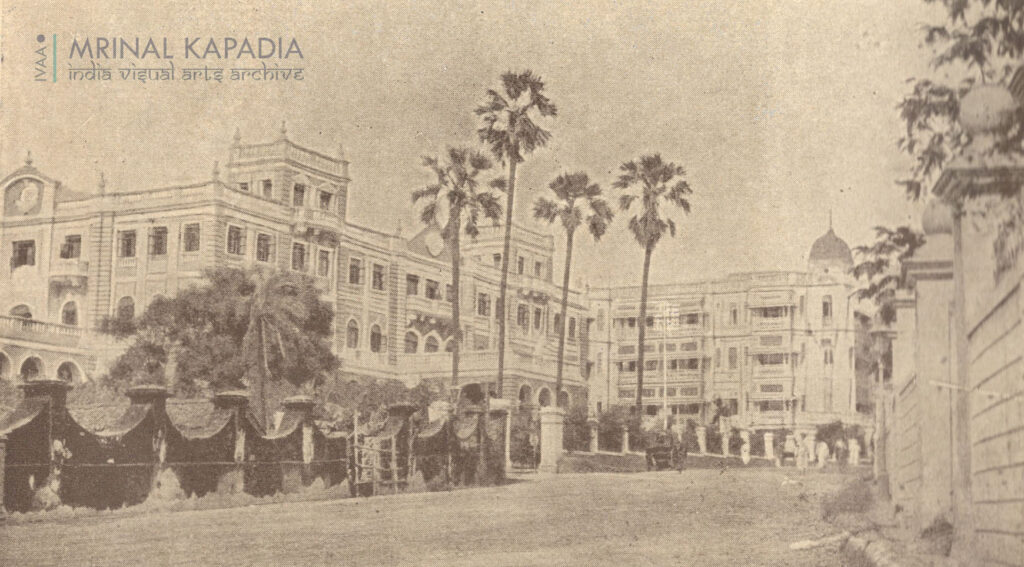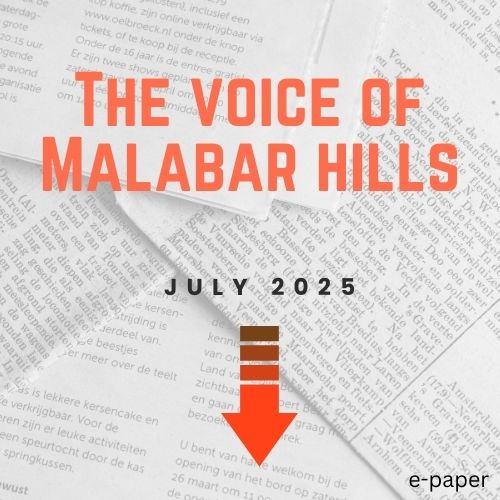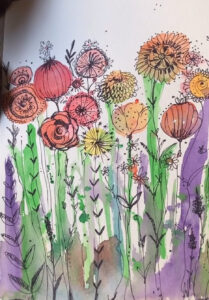
The Framjee Dinshaw Petit Parsi Sanatorium at Kemps Corner, built in the wake of the plague of 1896 out of a fund of INR 5 lakhs (for land acquisition and construction) set aside by it’s namesake, was made for temporary accommodation of upto 36 Parsi families in need of a home and was 293 x 75 feet in dimensions. A noticeable feature in connection with the sanitary arrangements of the building, presumably an outcome of the devastating effect of the plague on the city, was the introduction of the ‘Macerating Bacteriological Tanks’ for the disposal of sewage and sullage. Such was the description (paraphrased) as appeared in the National Geographic Magazine in 1905, marking the commencement of development on the stretch of August Kranti Road from the commencement of Warden (now Bhulabhai Desai) Road until the turn into Pedder Road.
Probably taken around 1920, the accompanying photograph shows the sanatorium in the left half and Banoo Mansion center-right, with longtime resident at the latter Dr. Shehernaz Nalwalla, Vice President of the Asiatic Society of Mumbai, ruing the disappearance of neighbourhood support systems like Allah Beli Restaurant and Aap ki Dukan, which “served lovely kheema for breakfast”, was a “cosy place” and regarded an “institution”. A common feature that occupants past and present appreciate is the wrought iron staircase, something that also struck Kunaal Roy Kapur, actor and ex-tenant, who reminisces climbing the marble steps and letting the traffic and commotion of the noisy main road fade away. For him, the thick walls, 13-foot ceiling height, wooden rafters, and beautiful hand-crafted mosaic tiles left no doubt one was in an old building (very much still on our city Heritage List, in fact upgraded from Grade III to II-B.)
Next door to Banoo Mansion (not visible in the photo here) is the plot that Joosub Cassum purchased in the 1930s, when the only bungalow in the compound was Aminia (still extant); old survey maps show it was accompanied by a large garden, which is now partially replaced by a smattering of buildings and other smaller units. I recall Zahir Cassum, Joosub’s grandson, telling me that they had a treehouse (“more like a plank on the mango tree”, he corrects me recently) growing up, while Aminia had a connecting plank to Adenwalla Lodge (Madhu Sagar building today) in the adjoining compound, linking two generations of the Khambata family. At one time, that compound plot too belonged to the Cassums, but while horse buggies parked to attend customers to and fro Doongerwadi across the road created a nuisance, the final straw was misuse of the space by vagrants, and promptly sold off to the Oomer family, who eventually built the India House buildings, which had the first “modern” flats in the neighbourhood. Zahir also recalls members of the locality, including his grandmother and subsequently his mother, going across the road to Palmer bakery in order to use one of the only ovens in the area, which was torn down in 1980 to make way for Om Chambers, poignantly captured by (screenwriter and) photographer Sooni Taraporevala.
A closing observation to this mini-series on the Kemps Corner area, which entailed the last few articles in this column – a horse carriage can be seen here in the middle-right, probably awaiting a customer from the sanatorium to alight; there is visual evidence that August Kranti Road, long named Gowalia Tank Road, existed at least as early as the 1770s in some form, connecting this space between Cumballa and Malabar Hills to the natural potable water source of Gowalia Tank (August Kranti maidan today), crucial to livelihood then, a literal watering hole for humans (local residents as well as East India Company officers) as well as fauna (cattle, ducks, jackals, hyenas, and even tigers!). By providential luck perchance did this distant suburb of Bombay dubbed ‘Hermitage Pass’ even gain prominence the way it did, being an appropriate enough distance from the town trading hub in Fort for stately country homes (and apartments) to appear, but an air of gentility take on it did, transforming into this thriving neighbourhood which truly lives up to the theme of this series: it was, and remains, a place in time.
(Picture and article by Mrinal Kapadia, resident of Cumballa Hill, he is a collector and researcher, and can be reached on mrinal.kapadia@gmail.com or via Instagram on @mrinal.kapadia)





